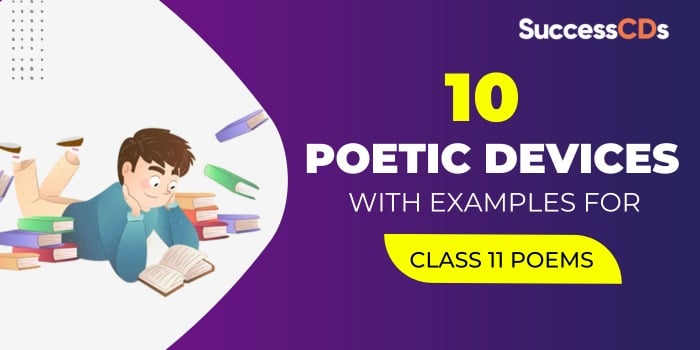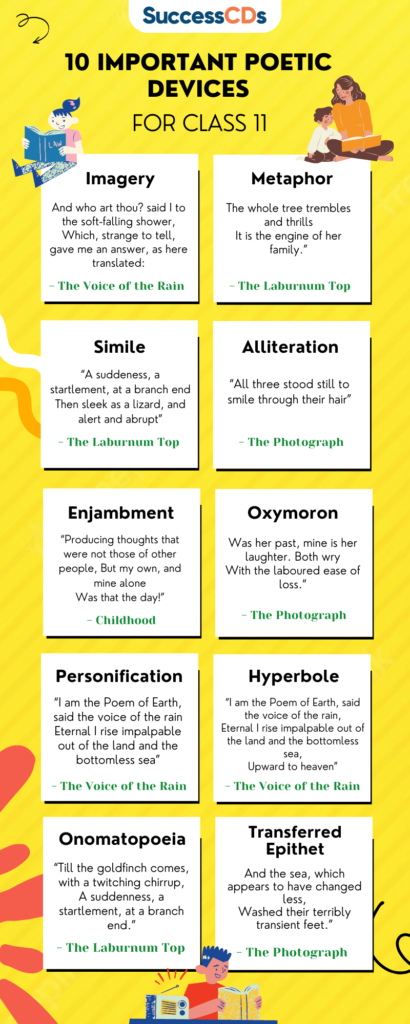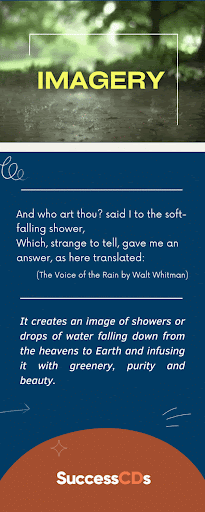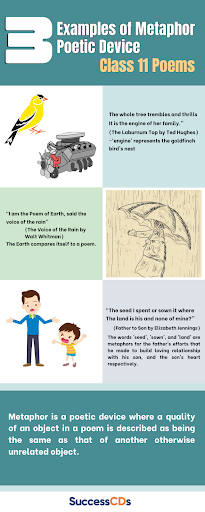
List of Top 10 Poetic Devices for Class 11 English Poems
Figures of speech are crucial for students to understand the hidden messages given by the poet. Let us put all speculation to rest by understanding all important figures of speech used in class 11 poems along with examples from the Hornbill book.
Let us see what do we mean by poetic devices-
What are Poetic Devices?
Poetic devices are an essential part of English poetry. They include a variety of syntactic, rhythmic, metrical, verbal, visual, structural, and other aspects that come together to make an enjoyable poem.
Poetry offers plenty of opportunities for exploration and experimentation of many notions, ideas, and concepts. Poetic devices are therefore tools that significantly enhance a poem’s substance, heighten its feel, or provide the essential rhythm. Understanding the different kinds of poetic devices employed can be an excellent way to develop your appreciation for the poetic art form.
To learn more about the 10 most significant poetic devices for CBSE Class 11, keep reading!

- Imagery
Imagery is a poetic device that allows writers to create pictures in readers’ minds with their vivid description, use of sound words, auditory devices, etc.
Example-
And who art thou? said I to the soft-falling shower,
Which, strange to tell, gave me an answer, as here translated:
(The Voice of the Rain by Walt Whitman)
It creates an image of showers or drops of water falling down from the heavens to Earth and infusing it with greenery, purity and beauty.

- Metaphor
Metaphor is a poetic device where a quality of an object in, or the subject of, a poem is described as being the same as that of another otherwise unrelated object.
Example-
“She enters the thickness,and a machine starts up
Of chitterings, and of tremor of wings,and trillings –
The whole tree trembles and thrills
It is the engine of her family.”
(The Laburnum Top by Ted Hughes)
‘engine’ represents the nest of the mother goldfinch, and ‘machine’ which represents the bird.
“I am the Poem of Earth, said the voice of the rain”
(The Voice of the Rain by Walt Whitman)
The poet uses a metaphor to compare a poem with the rain.
“The seed I spent or sown it where
The land is his and none of mine?”
(Father to Son by Elizabeth Jennings)
The words ‘seed’, ‘sown’, are metaphors for the son and the father’s efforts that he made to build loving relationship with his son, respectively

- Simile
The simile offers a device for comparison. The subject of the poem is described by comparing it to another object or subject, using ‘as’ or ‘like’.
Example-
“A suddeness, a startlement, at a branch end
Then sleek as a lizard, and alert and abrupt”
(The Laburnum Top by Ted Hughes)
The goldfinch bird’s leekness is compared to that of a lizard.
“We speak like strangers, there’s no sign
Of understanding in the air.”
(Father to Son by Elizabeth Jennings)
The father and son are compared to strangers.
- Alliteration
Alliteration is a poetic device in which a consonant sound is repeated at the beginning of closely placed words.
Example-
“All three stood still to smile through their hair”
(The Photograph by Shirley Toulson )
“The whole tree trembles and thrills”
(The Laburnum Top by Ted Hughes)
“Was it the time I realised that Hell and Heaven,
Could not be found in Geography”
(Childhood by Markus Natten)
- Enjambment
An enjambment is the continuation of a sentence beyond a line break, couplet, or stanza without an expected pause.
Example-
“Producing thoughts that were not those of other
people, But my own, and mine alone
Was that the day!”
(Childhood by Markus Natten)
- Oxymoron
An oxymoron is a figure of speech that combines contradictory words with opposing meanings. Oxymorons may seem illogical at first, but in context they usually make sense.
Example-
“The sea holiday
Was her past, mine is her laughter. Both wry
With the laboured ease of loss.”
(The Photograph by Shirley Toulson )
Laboured meaning with ‘great difficulty’ and ease means ‘comfortably’. Both words have opposite meanings but here they are clubbed together.
- Personification
Personification is a poetic device in which animals, plants, or even inanimate objects are endowed with human characteristics.
Example-
“I am the Poem of Earth, said the voice of the rain
Eternal I rise impalpable out of the land and the
bottomless sea”
(The Voice of the Rain by Walt Whitman)
The rain has been personified as it has been given a voice in the poem.
- Hyperbole
Example-
“I am the Poem of Earth, said the voice of the rain,
Eternal I rise impalpable out of the land and the bottomless sea,
Upward to heaven”
(The Voice of the Rain by Walt Whitman)
‘Bottomless sea’ is an example of hyperbole. The poet describes the sea as bottomless which is an exaggerated statement to bring out the desired effect.
- Onomatopoeia
Example-
“Till the goldfinch comes, with a twitching chirrup,
A suddenness, a startlement, at a branch end.”
(The Laburnum Top by Ted Hughes )
Chirrup means to make high-pitched sounds.
- Transferred Epithet
The term ‘epithet’ refers to an adjective or a phrase that modifies a noun in the sentence, most probably the subject. A transferred epithet is created when “an adjective appropriate to one noun is attached to another by association.”
Example-
And the sea, which appears to have changed less,
Washed their terribly transient feet.”
(The Photograph by Shirley Toulson )
Transient refers to human feet but it is used to describe the lack of permanence of human life.
“ She stokes it full, then flirts out to a branch-end
Showing her barred face identity mask
( The Laburnum Top by Ted Hughes)
The barred face refers to the entire body of the goldfinch bird
Also See :